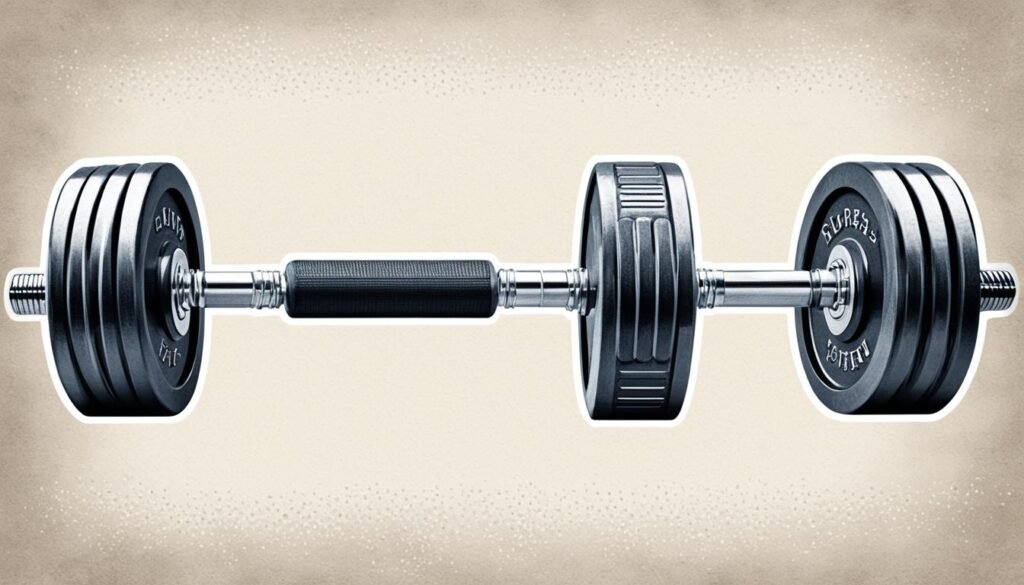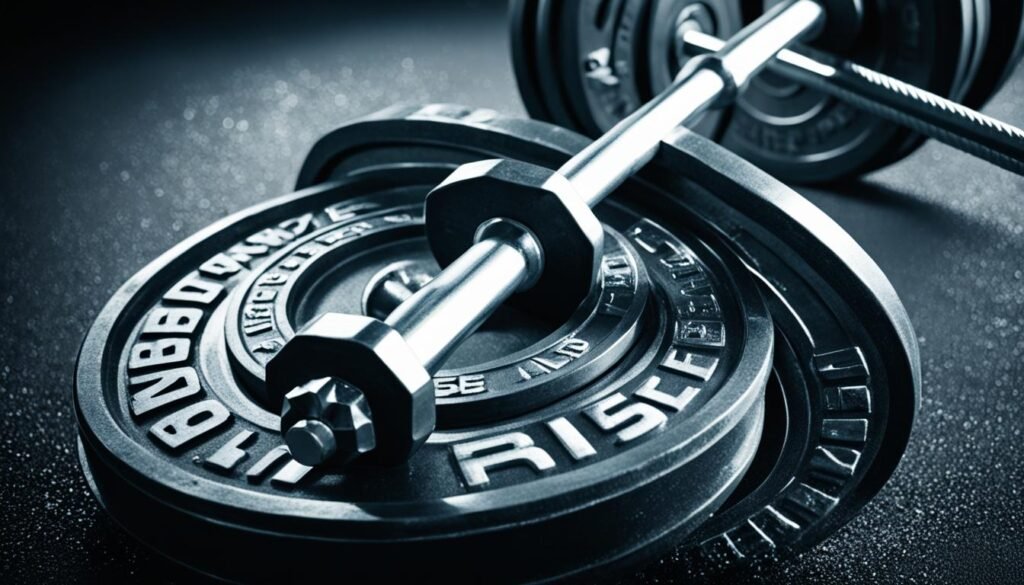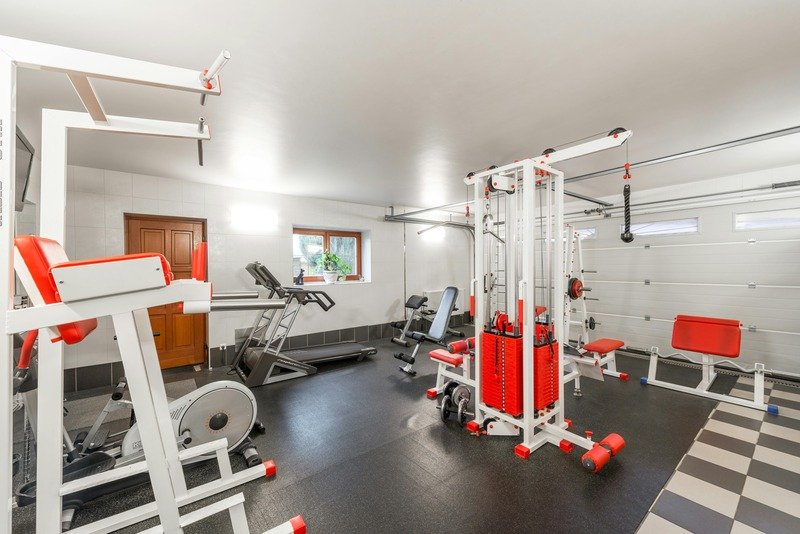We independently test and review fitness products using a research-based approach. If you buy through our links, we may earn a small commission at no extra cost to you. Read our Disclosure
If you’re wondering what’s the difference between dumbbells and barbells, the answer lies primarily in their design, which dictates how you lift and what muscles you target. Both are essential tools for building strength—offering significant benefits like reducing heart disease risk, promoting weight loss, and enhancing body composition—but their application differs greatly.
A barbell allows you to lift significantly heavier weight for foundational compound movements, while dumbbells offer a greater range of motion, enhance stability, and are key to fixing muscle imbalances. Your choice between them often depends on how much weight you can lift, the variety of exercises available, and your specific fitness goals.
Key Takeaways
Your decision on what’s the difference between dumbbells and barbells and which to prioritize hinges on your fitness goals, experience level, and available equipment.
Barbells are best for building overall strength and muscle mass, especially for competitive lifters and athletes focused on heavy compound lifts.
Dumbbells provide a greater range of motion, help improve joint flexibility, and are excellent for isolating and focusing on specific muscles.
Dumbbell exercises require and work your stabilizer muscles, boosting functional strength and balance.
The most complete training experience uses both barbells and dumbbells in a comprehensive routine.

Defining the Difference: What are Dumbbells and Barbells?
Barbells and dumbbells are the core tools in strength training. Understanding their physical differences is the first step in deciding how to use them to meet your goals.
What are Barbells?
Barbells are long metal bars with weight plates fixed on each end using collars.
- They are used for major lifts in sports like powerlifting, Olympic weightlifting, and CrossFit.
- Their fixed structure allows you to safely lift much heavier weight than dumbbells, which is perfect for building maximal strength and muscle mass through progressive overload.
What are Dumbbells?
Dumbbells feature a short handle with a fixed weight on either end, designed to be held in a single hand.
- They allow for a wider, more natural range of motion than barbells.
- This design makes them ideal for activating stabilizer muscles and is the most effective way to identify and correct muscle imbalances between your left and right sides.
- They are also easier to store, making them the superior choice for a home gym.
Lifting Heavier Weights with Barbells
When optimizing for pure strength gains and maximal muscle growth, barbells are the clear winner. Their design allows for greater stability, meaning you can load up the bar and challenge your muscles more effectively through progressive overload.
- Weight Capacity: Barbells enable individuals to lift more total weight compared to dumbbells because the weight is stabilized across both limbs.
- Compound Efficiency: They are easy to progressively load, which is critical for compound exercises (like squats and deadlifts) that work many muscles at once, leading to rapid gains in functional strength and power.
- Strength Sports: Barbells are non-negotiable in strength sports like CrossFit, powerlifting, and Strongman, where the ability to handle massive loads is paramount.
Full-Body Compound Exercises with Barbells
Barbells are the foundation for the most efficient full-body workout routines. The following compound exercises are essential for building strength across multiple muscle groups:
Overhead Press: Strengthens the shoulders, core, and triceps, improving overall shoulder stability.
Squats: Engage the quadriceps, glutes, and core, serving as the foundation for overall lower-body strength.
Deadlifts: Work the hamstrings, glutes, and back, crucial for building raw full-body power.
Bench Press: Targets the chest, shoulders, and triceps, essential for upper-body pressing strength.

Greater Range of Motion and Stability with Dumbbells
While barbells excel at lifting heavy, dumbbells are superior when it comes to training stability and achieving a greater range of motion (ROM). This is the other main point of what’s the difference between dumbbells and barbells.
Exposing and Correcting Muscle Imbalances
The unilateral nature of dumbbells—where each hand holds an independent weight—is key to injury prevention and balanced development.
Joint Health: The free movement path allows your joints to move more naturally, which can reduce strain compared to the fixed path of a barbell.
Unilateral Training: Since the stronger side cannot compensate for the weaker side, dumbbells force each muscle group to work equally. This helps expose and correct muscle imbalances over time.
Targeted Muscle Activation: Studies suggest that dumbbell presses can activate muscles like the pectoralis major (chest) and anterior deltoid (front of the shoulder) more effectively than barbell presses due to the increased freedom of movement.

Versatility of Dumbbells for Home Gyms
For those setting up a home gym, dumbbells often prove to be the more practical choice due to their versatility and small footprint.
| Feature | Dumbbells | Barbells |
|---|---|---|
| Space Requirement | Compact and easily stored (stackable or rack-based) | Require dedicated space for the rack, bar, and weight plates |
| Accessibility | Versatile for isolation and full-body movements | Primarily focused on heavy, fixed-path compound movements |
| Convenience | Can be used anywhere, portable | Requires a dedicated workout area |
| Muscle Targeting | Allows for isolation of specific muscle groups | Engages multiple muscle groups simultaneously |
When to Choose Barbells or Dumbbells
Your training tool of choice should align with your specific experience and goals.
| Goal / User Type | Primary Recommendation | Why? |
|---|---|---|
| Beginners | Dumbbells | Easier to learn and use safely, reducing initial injury risk while teaching muscle control. |
| Powerlifters/Bodybuilders | Barbells | Necessary for maximum progressive overload and building raw, absolute strength. |
| Runners / Athletes | Dumbbells | Great for strengthening connective tissues, boosting power, and improving balance, which aids in injury prevention for dynamic movement. |
| Injury Recovery / Imbalance | Dumbbells | Unilateral loading isolates the weaker side, accelerating correction and rehabilitation. |
Conclusion
Barbells and dumbbells are equally indispensable tools in strength training, each offering unique benefits. The difference between dumbbells and barbells boils down to function: barbells are for maximum load and compound strength, while dumbbells are for flexibility, isolation, and balanced stability.
For a complete, well-rounded program, the best approach is to utilize both. However, if the versatility and space-saving nature of dumbbells make them the perfect fit for your home gym setup, your next step is choosing the right equipment.
Find the ultimate space-saving equipment in our detailed breakdown: Best Adjustable Dumbbell Set for Home Gym Workouts: A Comprehensive Guide
FAQ
What are the key differences between barbells and dumbbells?
The main differences are in weight capacity, exercise types, and training benefits. Barbells allow you to lift more weight for strength and muscle mass, especially in compound lifts. Dumbbells offer a greater range of motion, enhance stability, and are essential for correcting muscle imbalances.
Why are barbells designed to lift heavier weights?
Barbells are designed to maximize weight because their fixed, two-handed grip provides maximum stability. This stability is key for progressive overload, the process of continually challenging muscles with heavier weight for growth.
What are the benefits of using dumbbells?
Dumbbells let you move your arms freely, which helps activate muscles better and allows for a greater range of motion. They also help fix muscle imbalances by working each side of the body independently.
Is it better to use barbells or dumbbells for beginners?
Beginners should typically start with dumbbells because they are easier to handle safely, require less technical skill, and are effective at teaching muscle isolation and control before moving to heavy barbell loads.



